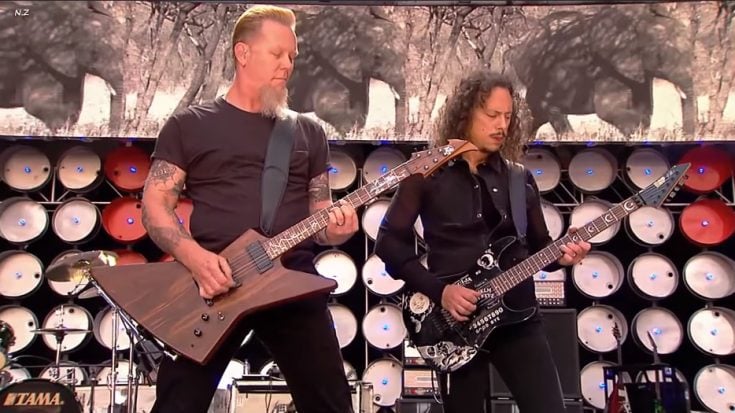The 10 Hardest Classic Rock Songs To Perform

Metallica performing at the Live Earth event at Wembley Stadium, 2007 - NEA ZIXNH / Youtube
While it’s definitely not illegal to bust out your guitar, drums, or vocal chords to your favorite classic rock tune, it would be wise to stick to those within the bounds of your skills. Songs that require technical skill, sense of timing, and even raw vocal power are present in the rock scene, and while some talented folks who have mastery over what they wield exist, succumb to the sheer difficulty of some of these tracks.
Let’s take a look at some of the most challenging classic rock songs to cover.
Sultans of Swing (Dire Straits – 1978)
The groovy track by the British rock band Dire Straits isn’t really the most complicated as it has four chord progressions for the verse and three for the chorus, but don’t let it fool you. The flamenco inspired progression features Mark Knopfler’s well timed licks and riffs, which occur in a common time setting. The triad he uses in the conclusion of the song is hard to deliver without a perfectly timed internal metronome.
Shine On You, Crazy Diamond (Pink Floyd – 1975)
This haunting, yet poignant tribute to Pink Floyd’s fallen member and friend, Syd Barrett, is another hard to nail track. While it isn’t all that technical, David Gilmour’s guitar solos and riffs are rooted in proper timing and delivery. His fingers are the only ones that can produce that tone of melancholy and fierceness at the same time. Not to mention the sheer length of the track, with a total of 25 minutes as a whole piece.
Master Of Puppets (Metallica – 1985)
With two intricate guitars at work, it won’t make the feat any easier. The rhythm part isn’t even safe from multiple complicated riffs, and arpeggios in sync with the lead. As for the lead, the task is exponentially increased with the addition of pinched harmonies and tremolo picking, with hint of blues in the mix. The 200 bpm isn’t for the average drummer, as you’d have to constantly maintain that tempo or risk derailing your bandmates.
Little Wing (The Jimi Hendrix Experience – 1967)
This unnatural Hendrix masterpiece ditches his known distortion techniques for a much mellower, twangier sound. This doesn’t make it an easy song to cover though, as Hendrix playfully wrote it to jump to a 2/4 time signature, packed with suspended notes, hammer-ons and pull-offs, that needs to be played with feel. It’s a shame we won’t be able to see it performed live by Hendrix himself.
Stairway To Heaven (Led Zeppelin – 1971)
The quintessential Led Zeppelin track, and one of their most known, is also one of the hardest to replicate. The song starts off seemingly slow and mellow, but as it goes past the five minute mark, Jimmy Page unleashes mayhem on his double-neck guitar, with Bonham’s drums following through with precise tempo, particularly an odd time signature shift in the middle of the track. And of course, the Golden God’s vocals, who would even dare to attempt a shot at it.
La Villa Strangiato (Rush – 1978)
One of Rush’s most intricate instrumental compositions, it starts off with a flamenco inspired intro, then speeds off into a lively, rock progression, before mellowing again into a drum fill with a lonely, yet powerful solo. The song is divided into twelve sections, with differing time signatures, which makes it a challenge for those who want to play it, as adaptability, especially in the drum portions, is critical to the success.
Bohemian Rhapsody (Queen – 1975)
Would you even want to attempt this one? While a hit song in karaokes all over the world, “Bohemian Rhapsody” is one of the most vocally demanding songs, especially when you follow Mercury’s performances in the 80’s. Gone are the subtle falsettos, replaced by full bodied rasps that fill arenas. One cannot ever reinvent the song to their own style, not even Marc Martel, who does the song justice with his impressionism.
Voodoo Child (The Jimi Hendrix Experience – 1968)
This time, the signature overdriven sound of Hendrix is featured in this song. A repeating progression is plagued by various licks that can only be achieved with Hendrix’s impeccable timing and speed, and the fiery solo at the end of the track followed by crazy shreds can only be explained by the tracks title. The hard to replicate sound encompasses the usage of multiple audio channels for a hypnotic effect.
Fracture (King Crimson – 1974)
This progressive instrumental track is sure to blow your wits out with its unconventional time signature shifts, and overall progression changes. Coming off as a heavy lick laden track, it mellows down into a silent portion with drum trills across, the pattern repeating but with different chord arrangements. This is chaos controlled, and sounds pretty good when executed well, but for the ambitious cover band, you’re better off finding a more standard track.
Maggot Brain (Funkadelic – 1971)
This psychedelic funk track is an emotion-filled blast from the past with its guttural distorted guitar parts. The amount of control in the effects for the guitars is a refined art that needs to be learned by ear, as overdoing it kills the feeling of the song. With some sort of flamenco and rockabilly flair nearing the end of the track, the distorted wail once again echoes throughout with almost pinpoint accuracy.





















